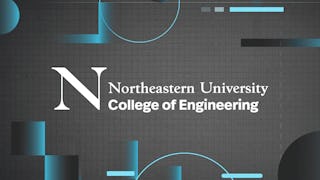This course will offer you an opportunity to learn the fundamental concepts and emerging technologies in data storage and data governance. It presents a balanced theory-practice focus and covers Structured Query Language, and two flavors of NoSQL databases in MongoDB and Neo4j graph database. It also includes a brief introduction to big data management including hadoop, MapReduce, and Apache Spark. By the end of this part 2 course on data analytics, you will have a foundational understanding of the theory and applications of database management to support data analytics, data mining, machine learning, and artificial intelligence.



Kompetenzen, die Sie erwerben
- Kategorie: MongoDB
- Kategorie: Distributed Computing
- Kategorie: Database Management Systems
- Kategorie: Graph Theory
- Kategorie: Database Management
- Kategorie: SQL
- Kategorie: Databases
- Kategorie: Relational Databases
- Kategorie: Stored Procedure
- Kategorie: NoSQL
Wichtige Details

Zu Ihrem LinkedIn-Profil hinzufügen
Juli 2025
36 Aufgaben
Erfahren Sie, wie Mitarbeiter führender Unternehmen gefragte Kompetenzen erwerben.

In diesem Kurs gibt es 6 Module
This module first presents an overview of the structured query language (SQL) Data Definition Language (SQL DDL) to define a relational data model. It examines the schema creation, table creation, drop command, and alter command. Various syntaxes are illustrated with explicit examples. This module also discusses the SQL Data Manipulation Language (SQL DML) used to retrieve data, update data, insert new data, and delete existing data. The focus is on SQL INSERT statements for inserting data into tables and some simple SQL SELECT statements. More complex SQL SELECT statements will be discussed in later modules along with SQL DELETE and SQL UPDATE statements.
Das ist alles enthalten
1 Video10 Lektüren7 Aufgaben
This module continues the discussion of the SQL data manipulation language (DML) SELECT statement. It introduces various aggregate functions: COUNT, SUM, AVG, VARIANCE, MIN, and MAX, which are used to summarize information from database tuples. This is followed by the GROUP BY/HAVING clause, which allows the application of aggregate functions to subgroups. This module then discusses join queries that allow the user to combine or join data from multiple tables. The inner join queries feature a “where” clause that matches one or multiple columns from two tables. The left outer join, right outer join, and full outer join can be used to keep all the tuples of one or both tables in the result, regardless of whether or not they have matching tuples in the other table. All queries in this module use the Wine database in the online playground and can be executed there.
Das ist alles enthalten
1 Video6 Lektüren6 Aufgaben
This module presents more complex SQL queries. It introduces nested queries where a complete SELECT FROM block appears in the WHERE clause of another query. The subquery or inner block is nested in the outer block and there can be multi-level nesting. The query optimizer usually flattens the nested query into multiple queries and executes them sequentially from the innermost to the outermost level. This module also examines the correlated nested query, where the inner block uses one or more columns of the table defined in the outer block. In this case, the query cannot be flattened, and the inner block subquery must be evaluated for each tuple of the table (also used in the inner block). The usage of the operators >= ALL and > ANY is discussed. The former can be used to find the highest or largest values whereas the latter can be used to exclude the lowest or smallest values. All queries in this module use the Wine database in the online playground and can be executed there. Finally, this module examines the DELETE and UPDATE statements that can be used to delete or modify data. It concludes with a brief discussion of SQL views.
Das ist alles enthalten
2 Videos10 Lektüren10 Aufgaben
This module introduces a couple of extensions to the Relational Database Management Systems (RDBMSs). We will start by reviewing the core components of the relational model and its limitations. Subsequently, the module explores methods for extending relational databases, starting with a thorough review of triggers and stored procedures as pivotal mechanisms for augmenting the activity of RDBMSs. The module concludes by delving into the intricacies of recursive queries, a powerful extension to the SQL language.
Das ist alles enthalten
4 Lektüren4 Aufgaben
This module presents an overview of the NoSQL movement and distributed systems. MongoDB NoSQL database is discussed at the introductory level. MongoDB is intended for storing documents such as resumes, legal documents, books, etc. It does not use any schema or data model, and stores documents as collections — which store a collection of attributes labeled and unordered that represent semi-structured items.
Das ist alles enthalten
5 Lektüren5 Aufgaben
This module continues the discussion of the NoSQL database. The graph theory and Neo4j graph database are discussed at the introductory level. The Neo4j is a graph database that applies graph theory to information storage. It consists of nodes and edges, both of which can store information. Graph databases are particularly useful in modeling social networks such as X (formerly known as Twitter) and Facebook. In a way, a graph database is a hyper-relational database where join tables are replaced by more interesting and semantically meaningful relationships that can be navigated (graph traversal) and/or queried, based on graph pattern matching.
Das ist alles enthalten
5 Lektüren4 Aufgaben
Erwerben Sie ein Karrierezertifikat.
Fügen Sie dieses Zeugnis Ihrem LinkedIn-Profil, Lebenslauf oder CV hinzu. Teilen Sie sie in Social Media und in Ihrer Leistungsbeurteilung.
Auf einen Abschluss hinarbeiten
Dieses Kurs ist Teil des/der folgenden Studiengangs/Studiengänge, die von Northeastern University angeboten werden. Wenn Sie zugelassen werden und sich immatrikulieren, können Ihre abgeschlossenen Kurse auf Ihren Studienabschluss angerechnet werden und Ihre Fortschritte können mit Ihnen übertragen werden.¹
Dozent

Mehr von Software Development entdecken
 Status: Kostenloser Testzeitraum
Status: Kostenloser Testzeitraum Status: Vorschau
Status: VorschauNortheastern University
 Status: Kostenloser Testzeitraum
Status: Kostenloser TestzeitraumLearnKartS
 Status: Kostenloser Testzeitraum
Status: Kostenloser TestzeitraumWhizlabs
Warum entscheiden sich Menschen für Coursera für ihre Karriere?





Neue Karrieremöglichkeiten mit Coursera Plus
Unbegrenzter Zugang zu 10,000+ Weltklasse-Kursen, praktischen Projekten und berufsqualifizierenden Zertifikatsprogrammen - alles in Ihrem Abonnement enthalten
Bringen Sie Ihre Karriere mit einem Online-Abschluss voran.
Erwerben Sie einen Abschluss von erstklassigen Universitäten – 100 % online
Schließen Sie sich mehr als 3.400 Unternehmen in aller Welt an, die sich für Coursera for Business entschieden haben.
Schulen Sie Ihre Mitarbeiter*innen, um sich in der digitalen Wirtschaft zu behaupten.
Häufig gestellte Fragen
Access to lectures and assignments depends on your type of enrollment. If you take a course in audit mode, you will be able to see most course materials for free. To access graded assignments and to earn a Certificate, you will need to purchase the Certificate experience, during or after your audit. If you don't see the audit option:
The course may not offer an audit option. You can try a Free Trial instead, or apply for Financial Aid.
The course may offer 'Full Course, No Certificate' instead. This option lets you see all course materials, submit required assessments, and get a final grade. This also means that you will not be able to purchase a Certificate experience.
When you purchase a Certificate you get access to all course materials, including graded assignments. Upon completing the course, your electronic Certificate will be added to your Accomplishments page - from there, you can print your Certificate or add it to your LinkedIn profile. If you only want to read and view the course content, you can audit the course for free.
You will be eligible for a full refund until two weeks after your payment date, or (for courses that have just launched) until two weeks after the first session of the course begins, whichever is later. You cannot receive a refund once you’ve earned a Course Certificate, even if you complete the course within the two-week refund period. See our full refund policy.
Weitere Fragen
Finanzielle Unterstützung verfügbar,
 enthalten
enthalten
